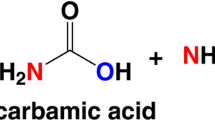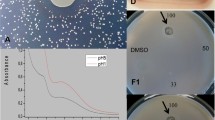Abstract
EVIDENCE has already been obtained to show that an important mechanism of the toxic action of fungicides is the inhibition of fungus enzymes. Copper and mercury are known to inhibit different systems, including those concerned with carbohydrate metabolism1. Rich and Horsfall2 have investigated the action of phenols and quinones upon polyphenol oxidase, while Owens3 has examined the effect of organo-sulphur compounds, phenols, quinones and metal compounds upon amylases, polyphenol oxidase and catalase. Attention has been given to the mode of action of different types of derivatives of thiocarbamic acid. Weed, McCallan and Miller4 found that ferbam (ferric dimethyldithiocarbamate) inhibited urease, whereas nabam (disodium ethylene bisdithiocarbamate) had little effect. Sisler and Cox5 attribute the toxicity of thiram (bis(dimethylthiocarbamoyl) disulphide) largely to the inhibition of the enzyme triosephosphate dehydrogenase. The activity of 8-hydroxyquinoline has been ascribed6 to chelation with metal ions essential for enzyme action. Owens7 has shown that captan (N-trichloromethylthio-cyclcohex-4-ene-1,2-dicarboxyimide) prevents the assimilation of inorganic phosphate, and Hochstein, Cox and Sisler8 have reported that this compound affects cellular metabolism by blocking key decarboxylation reactions.
This is a preview of subscription content, access via your institution
Access options
Subscribe to this journal
Receive 51 print issues and online access
$199.00 per year
only $3.90 per issue
Buy this article
- Purchase on Springer Link
- Instant access to full article PDF
Prices may be subject to local taxes which are calculated during checkout
Similar content being viewed by others
References
Barren, E. S. G., and Singer, T. P., J. Biol. Chem., 157, 221, 241 (1945).
Rich, S., and Horsfall, J. G., Proc. U.S. Nat. Acad. Sci., 40, 139 (1954).
Owens, R. G., Contr. Boyce Thompson Inst., 17, 221 (1953); 17, 473 (1954).
Weed, R. M., McCallan, S. E. A., and Miller, L. P., Contr. Boyce Thompson Inst., 17, 473 (1954).
Sisler, H. D., and Cox, C. E., Amer. J. Bot., 41, 338 (1954).
Rubbo, S. D., Proc., 4th Int. Microbiol. Congr., Copenhagen, 149 (1947). Vicklund, R. E., Manowitz, M., and Bagdon, V. J., Mycologia, 46, 133 (1954).
Owens, R. G., Phytopath., 46, 23 (1956).
Hochstein, P. E., Cox, C. E., and Sisler, H. D., Phytopath., 44, 492 (1954).
Author information
Authors and Affiliations
Rights and permissions
About this article
Cite this article
BYRDE, R., MARTIN, J. & NICHOLAS, D. Effect of Fungicides on Fungus Enzymes. Nature 178, 638–639 (1956). https://doi.org/10.1038/178638b0
Issue Date:
DOI: https://doi.org/10.1038/178638b0
This article is cited by
-
Zur Kenntnis der antimikrobiellen Wirkung von Biphenyl und Derivaten des Biphenyls
Zeitschrift für Lebensmittel-Untersuchung und -Forschung (1968)
-
Zur Enzymhistochemie von Dermatophyten
Archiv f�r Klinische und Experimentelle Dermatologie (1967)
-
Zur Kenntnis der antimikrobiellen Wirkung von Biphenyl und Derivaten des Biphenyls
Zeitschrift für Lebensmittel-Untersuchung und -Forschung (1967)
-
Zur Physiologie der Kupferwirkung auf Conidien von Fusarium decemcellulare (Brick)
Archiv f�r Mikrobiologie (1960)
-
Studien zur Fungicidwirkung der Schwermetallsalze
Archiv f�r Mikrobiologie (1958)
Comments
By submitting a comment you agree to abide by our Terms and Community Guidelines. If you find something abusive or that does not comply with our terms or guidelines please flag it as inappropriate.



